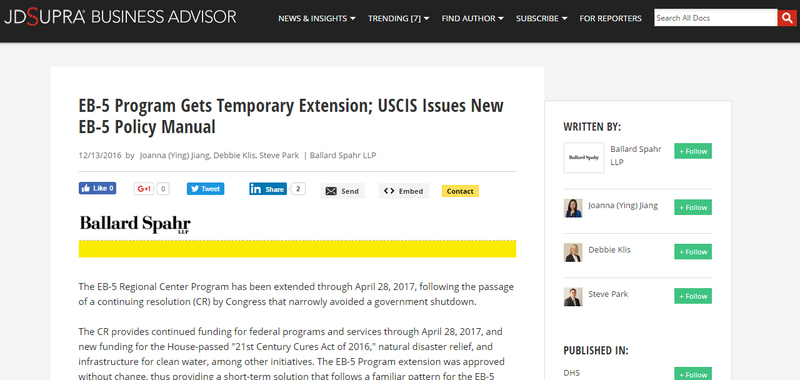EB-5 Program Gets Temporary Extension; USCIS Issues New EB-5 Policy Manual
The EB-5 Regional Center Program has been extended through April 28, 2017, following the passage of a continuing resolution (CR) by Congress that narrowly avoided a government shutdown.
The CR provides continued funding for federal programs and services through April 28, 2017, and new funding for the House-passed "21st Century Cures Act of 2016," natural disaster relief, and infrastructure for clean water, among other initiatives. The EB-5 Program extension was approved without change, thus providing a short-term solution that follows a familiar pattern for the EB-5 Program. Over the past 18 months, anxiety has ensued on a number of occasions over proposed sweeping legislative changes or even expiry of the program, then a temporary fix results, extending the program for a matter of months (e.g., three months, followed by 12 months, and now four months). The EB-5 program provides a green card to foreign investors who invest a minimum of $1 million, or $500,000 in targeted employment areas, in job-creating companies and real estate projects.
News reports from Capitol Hill indicate that attempts were made among the House Judiciary Committee chair, ranking Judiciary Committee members, and leaders of the EB-5 industry in the week preceding the CR vote to devise comprehensive EB-5 Program reform to include within the CR. However, in the end, it appears this group lacked adequate time to achieve a final proposal to include.
USCIS Issues New EB-5 Policy Manual
On November 30, 2016, U.S. Citizenship and Immigration Services (USCIS) published USCIS Policy Manual Volume 6, Part G in draft (Manual), which furnishes EB-5 Program guidance in connection with regional centers and immigrant investors. The Manual integrates, expands upon, and replaces previous policy guidance issued in the USCIS Adjudicator's Field Manual (AFM), the AFM appendices, and USCIS policy memoranda issued from time to time, including the highly popular May 30, 2013, USCIS Policy Memo.
The Manual supersedes any previously issued USCIS guidance, causing the new Manual to be viewed as the go-to source for EB-5 Program guidance. Regarding content, the Manual does not seem to affect investors significantly, as most of its content is procedural and directed to regional centers, the job-creating entities, and immigration counsel.
New Filing Fee Reminder
As reported by Ballard Spahr's EB-5 Group on November 8, 2016, the Department of Homeland Security has instituted new and increased filing fees in the EB-5 Program effective on December 23, 2016. Consequently, as a reminder, Ballard Spahr's EB-5 Group encourages interested participants to file Form I-924A for the fiscal year ended September 30, 2016, before December 23, in order to postpone the inaugural filing fee by one year; and to file any Form I-924s for a new regional center or to obtain USCIS exemplar approval before December 23 to avoid the substantially higher filing fee of $17,795 rather than $6,230.
http://www.jdsupra.com/legalnews/eb-5-program-gets-temporary-extension-89152/
Mentions
States
- New York
Videos





Subscribe for News
Site Digest
Join Professionals on EB5Projects.com →
Securities Disclaimer
This website is for informational purposes only and does not constitute an offer or solicitation to sell shares or securities. Any such offer or solicitation will be made only by means of an investment's confidential Offering Memorandum and in accordance with the terms of all applicable securities and other laws. This website does not constitute or form part of, and should not be construed as, any offer for sale or subscription of, or any invitation to offer to buy or subscribe for, any securities, nor should it or any part of it form the basis of, or be relied on in any connection with, any contract or commitment whatsoever. EB5Projects.com LLC and its affiliates expressly disclaim any and all responsibility for any direct or consequential loss or damage of any kind whatsoever arising directly or indirectly from: (i) reliance on any information contained in the website, (ii) any error, omission or inaccuracy in any such information or (iii) any action resulting therefrom.



